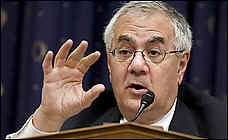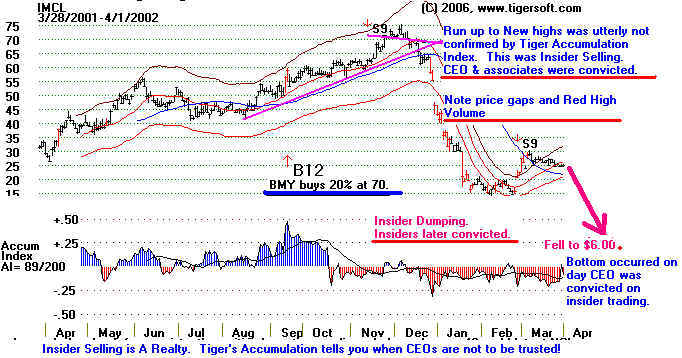| Daily Blog - Tiger Software
People have asked me to
write a Daily Blog. They seem to want |
Thursday
- June 28, 2007 - Who's Guarding The Investors' Hen
House?
New SEC Chairman Cox and Investor Protection
The issue of a toothless, for show only, Securities and Exchange
Commission will
not go away. On the one hand, Wall Street's crooks
are always busy finding new ways
to rig stocks and fleece investors. On the other hand, the
SEC is charged with protecting
investors and keeping the playing field fair. But it's an
uneven battle. Those on the inside have all
the advantages, especially if the SEC is understaffed and lacks
the will and muscle to
protect investors. I have focused www.tigersoftware.com on this imbalance. I always
come back to the notion that investors have to look affter their
own interests. And one of
the very best is to use Tiger Software's Accumulation Index and also Joe Granville's OBV
Line. Let the market tell its own story. We can
usually spot insider selling, long before it is reported.
I read with
interest how the new SEC Chairman's style and priorities are becoming
clear after being appointed a year ago. When his
appointment was announced, the LA Times
ran an article by Michael Hiltzik on June 9, 2005 with the
headline
Cox's Past Ties to Con Man Raise Questions
"In
the halls of Congress, Rep. Christopher Cox (R-Newport Beach), who has just been
nominated to be the nation's top securities
regulator, stands out for his intelligence.
"When
it comes to the work he performed as a lawyer for one of the state's most notorious
con men, however, he pleads ignorance. Apparently he
was unaware that William E. Cooper
was a crook or that his company, First Pension Corp., was a
fraud. In 1985, when Cox assured
state securities regulators that a new Cooper investment
scheme would be "low risk" and an absolute
boon to small investors trying to save for retirement, he
was apparently unaware that the scheme
was really designed to hide the losses already incurred by
Cooper's investors and to keep the scam
alive. In 1991, when Cooper hosted a fundraiser for Cox at his
Villa Park home, Cox thought of him
as merely "an upstanding member of the community.
"A few years after
that, the fraud finally exposed, Cooper and two partners went to jail. And now,
Cox has been nominated by President Bush as chairman of the
Securities and Exchange Commission."
Back in 1995, as a
Congressman, Christopher Cox had authored a bill which became the
Private Securities Litigation Reform Act of 1995. This changed the
long-standing Securities Exchange Act
of 1934. It required a plaintiff to identify in his
complaint each Insider statement which is alleged to have
been misleading. Seems reasonable.
Most important, Cox's legislation required the shareholder-plaintiff to prove that the
Insider knew
the challenged statement was false at the time. This
is important because shareholders often do not
have access to proof of what the state of mind was of the
Insider. Again quoting from wikopedia.com,
"This requirement allows defendants to obtain dismissal of
cases where the plaintiff merely points to a
false statement and declares that the defendant "must have
known" that the statement was false,
based upon his position within the company. This requirement has frequently proven difficult for
plaintiffs
to overcome because, without the benefit of discovery, plaintiffs
often do not have access to witnesses or
documents that might prove the defendant's state of mind in
making the false statement." Critics called
this piece of legislation, the "Ken Lay Protection
Act".
Background: The 1934
Securities legislation:
(quoting now from wikepdia.com) "gives shareholders the right to bring a private
action in
federal court to recover damages the shareholder sustained as a result of securities
fraud.
To make a such case against an insider, the Supreme Court as ruled that the:
1. The defendant made a "material misrepresentation or
omission";
2. The defendant intended to make the material
misrepresentation/omission,
or acted with recklessness in making the misrepresentation/omission);
3. The material misrepresentation/omission was made "in connection
with the purchase or
sale of a security";
4. The plaintiff who was allegedly victimized by the fraud relied upon
the material
misrepresentation/omission.
5. The plaintiff suffered an economic loss as a result of the alleged fraud;
and
6. The plaintiff can allege and prove "loss causation," which means
that the allegedly
fraudulent misrepresentation or omission caused the plaintiff's economic loss.
See Dura Pharmaceuticals, Inc. v.
Broudo, 544 U.S. 336 (2005).
Yesterday, CNN reported that the new SEC Chairman had appeared before the House of
Representative's Financial Services
Committee, chaired by Massachusetts Barney Frank
 To the surprise of his critics, the hearing was not heated
To the surprise of his critics, the hearing was not heated
or contentious. But what did emerge
was that the SEC had voted to support investors in a
Supreme Court case that could determine
liability for Enron's "secondary actors," but after
talking to President Bush, Cox
discouraged the SEC and the Solicitor General from acting
as a "friend of the court"
(amicus curiae) and siding with the investors. President Bush stated
it would be better for business and the
economy if the SEC regulated insiders, rather than
letting independent lawyers do it through
investors' law suits.
(http://www.cfo.com/article.cfm/9333431?f=related&x=1 )
The SEC has sued " secondary actors for helping Enron to misrepresent its
financial health
before its collapse in 2001.
As of February, 2007, the SEC has collected $440 million from
settlements and enforcement actions
against individuals and business partners (including some
banks) that it accused of
participating in Enron's fraudulent activities. The SEC
has not yet
announced a distribution plan for the
funds!. (Sarah Johnson, www.cfo.com - June 13,
2007).
See http://www.washingtonpost.com/wp-dyn/content/article/2007/06/13/AR2007061302124.html
It's Very Risky To Trust Most CEO's.
Trust TigerSoft To Reveal The Truth about What They Are Doing with Their Own Money!
The 2001-2002 Decline of Imclone shows how irresponsible and selfish
insiders can be.
ImClone's Sam Waksal Pleads
Guilty

NEW YORK, Oct. 15--Samuel Waksal, founder and
former chief executive of ImClone Systems Inc.,
pleaded guilty to six criminal charges this morning in the
insider-trading case that has
ensnared lifestyle guru Martha Stewart.
Waksal, who resigned from the New York-based biotechnology company earlier this year
amid
growing controversy, pleaded guilty in federal court to charges of securities fraud,
perjury, bank
fraud and obstruction of justice. The charges carry a maximum prison sentence of 65 years.
"I am aware that my conduct, while I was in possession of material non-public
information,
was wrong," Waksal told the judge.
Waksal had been charged with 13 counts on June 12. It was not immediately clear if the
remaining charges would be taken to trial, but prosecutors said there had not been a plea
agreement leading to Waksal's actions today.
Waksal has been negotiating with prosecutors for weeks to try to secure a lighter
sentence
and to protect family members who have also been targeted in the probe.
Prosecutors have been discussing whether to bring charges against Waksal's father,
Jack,
and his daughter Aliza. They are accused of selling about $10 million worth of ImClone
shares
after being tipped off by Samuel Waksal about impending bad news about the ImClone's main
product, the cancer-fighting drug Erbitux. Stewart, a close friend of Samuel Waksal's,
sold
nearly 4,000 shares of ImClone, worth about $230,000.
The questionable stock sales took place just before the firm announced late last year
that the
Food and Drug Administration had rejected an initial application to approve Erbitux, a
drug that
showed early promise in treating colorectal cancer. ImClone shares, already dropping,
began a
steep decline after the Erbitux announcement. Stewart has said she sold because she had a
prearranged
agreement to liquidate her ImClone holdings when the share priced dropped below $60, as it
did on
Dec. 27, the day of her sale. ImClone announced the FDA decision Dec. 28.
But Merrill Lynch, the brokerage firm that handled Stewart's
trade, turned up no solid evidence
of such an agreement in an internal investigation. And an assistant to Stewart's Merrill
Lynch
broker pleaded guilty early this month to helping concoct the story of the
"stop-loss" agreement.
The assistant, Douglas Faneuil, told a judge that the Merrill broker, Peter Bacanovic,
gave him
extra vacation and an airline ticket to mislead Securities and Exchange Commission and FBI
investigators about what he knew.
Legal experts have said Faneuil's plea would put pressure on Bacanovic to cooperate in
the
ImClone investigation. Neither Bacanovic nor Stewart has been charged with any crime.
Prosecutors are said to be considering charges of both insider trading and obstruction of
justice against Stewart, chief executive of Martha Stewart Living Omnimedia Inc.
An attorney for Stewart could not be reached for comment regarding Waksal's anticipated
guilty
plea. Shares in Stewart's company have suffered badly under months of tabloid headlines
surrounding
her ImClone trade.
In August, Waksal, a New York socialite long known for his lavish parties and famous
friends,
pleaded not guilty to multiple counts of securities and bank fraud.
The bank-fraud charge alleges that he used ImClone shares he no longer controlled to
secure
$44 million in loans from Bank of America. That charge, the most serious of the 13 counts
a
gainst Waksal, carries a maximum sentence of 30 years in prison. He also is charged with
obstruction of justice and a handful of other offenses.
Prosecutors allege that two Waksal family members, identified by sources as his father
and
daughter, started quickly selling their ImClone shares in late December after Samuel
Waksal
alerted them to the impending bad news. Waksal also allegedly attempted to sell $5 million
of his own ImClone shares through a family member's account but had the sales refused by
brokers who cited a company ban on insider sales.
A source familiar with the case said recently that prosecutors had been negotiating a
plea
arrangement with Waksal's attorneys. Talks broke down, the source said, when the two
sides could not agree on the size of a fine or the length of a prison term.